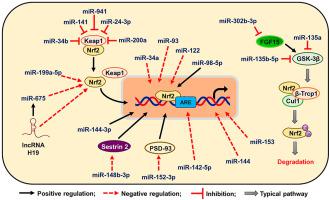Archives of Biochemistry and Biophysics ( IF 3.8 ) Pub Date : 2020-12-14 , DOI: 10.1016/j.abb.2020.108725 Ganesan Padmavathi 1 , Kunka Mohanram Ramkumar 2

|
Ischemia/reperfusion injury (IRI) initiates from oxidative stress caused by lack of blood supply and subsequent reperfusion. It is often associated with sterile inflammation, cell death and microvascular dysfunction, which ultimately results in myocardial, cerebral and hepatic IRIs. Reportedly, deregulation of Nrf2 pathway plays a significant role in the oxidative stress-induced IRIs. Further, microRNAs (miRNAs/miRs) are proved to regulate the expression and activation of Nrf2 by targeting either the 3′-UTR or the upstream regulators of Nrf2. Additionally, compounds (crocin, ZnSO4 and ginsenoside Rg1) that modulate the levels of the Nrf2-regulating miRNAs were found to exhibit a protective effect against IRIs of different organs. Therefore, the current review briefs the impact of ischemia reperfusion (I/R) pathogenesis in various organs, role of miRNAs in the regulation of Nrf2 and the I/R protective effect of compounds that alter their expression.
中文翻译:

MicroRNA介导的主要氧化还原稳态开关Nrf2的调节及其对氧化应激诱导的缺血/再灌注损伤的影响
缺血/再灌注损伤(IRI)是由血液供应不足和随后的再灌注引起的氧化应激引发的。它通常与无菌性炎症、细胞死亡和微血管功能障碍有关,最终导致心肌、大脑和肝脏 IRI。据报道,Nrf2 通路的失调在氧化应激诱导的 IRI 中发挥着重要作用。此外,microRNA (miRNA/miR) 被证明可以通过靶向 Nrf2 的 3'-UTR 或上游调节因子来调节 Nrf2 的表达和激活。此外,调节 Nrf2 调节 miRNA 水平的化合物(藏红花素、ZnSO 4和人参皂苷 Rg1)被发现对不同器官的 IRI 具有保护作用。因此,本综述简要介绍了缺血再灌注 (I/R) 发病机制对各器官的影响、miRNA 在 Nrf2 调节中的作用以及改变其表达的化合物的 I/R 保护作用。











































 京公网安备 11010802027423号
京公网安备 11010802027423号